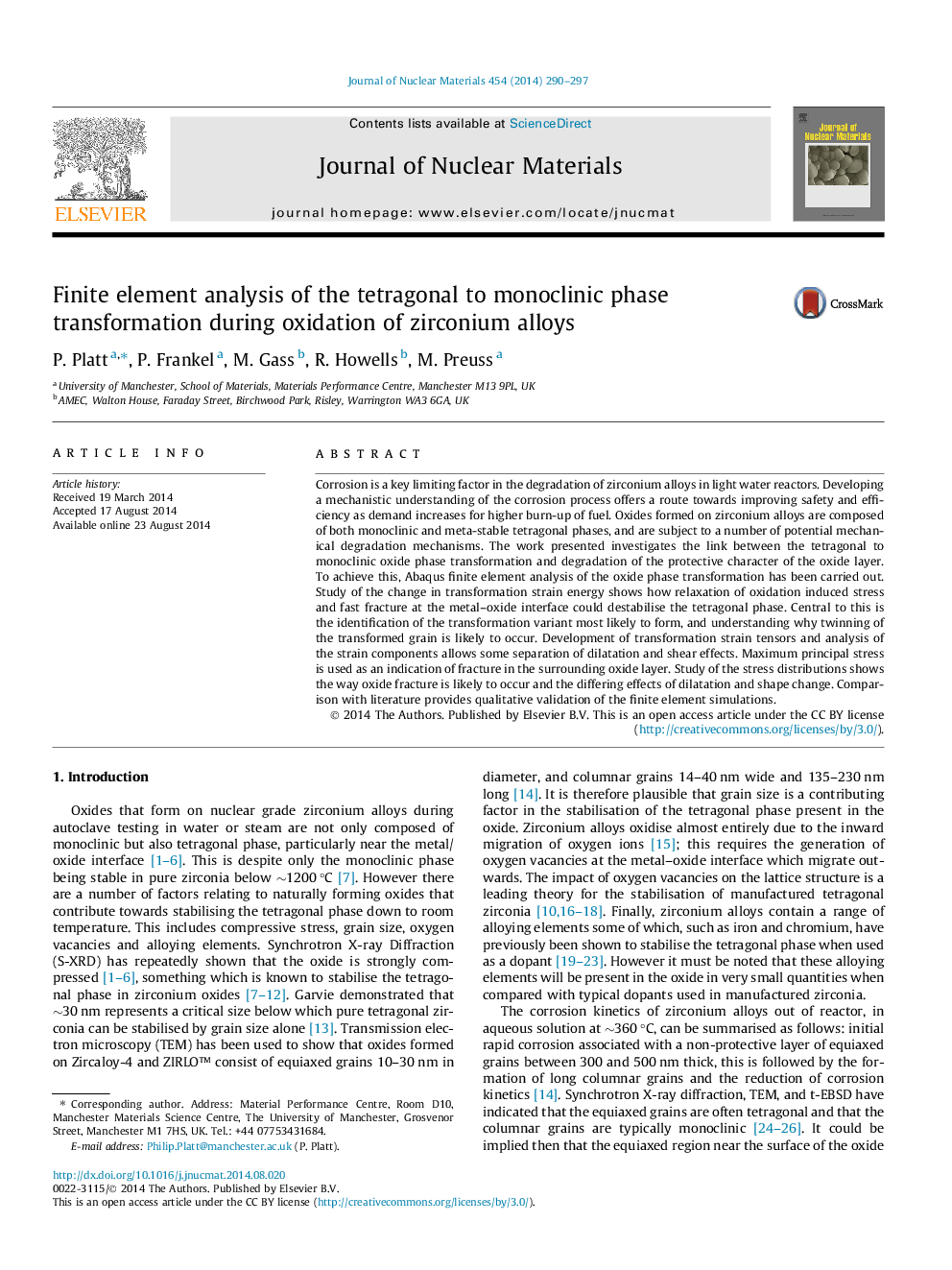| کد مقاله | کد نشریه | سال انتشار | مقاله انگلیسی | نسخه تمام متن |
|---|---|---|---|---|
| 7967338 | 1514191 | 2014 | 8 صفحه PDF | دانلود رایگان |
عنوان انگلیسی مقاله ISI
Finite element analysis of the tetragonal to monoclinic phase transformation during oxidation of zirconium alloys
ترجمه فارسی عنوان
تجزیه و تحلیل عناصر محدود از تبدیل تتراگونال به تک سلولی فاز در اکسیداسیون آلیاژهای زیرکونیوم
دانلود مقاله + سفارش ترجمه
دانلود مقاله ISI انگلیسی
رایگان برای ایرانیان
ترجمه چکیده
خوردگی عامل مهمی در تخریب آلیاژهای زیرکونیوم در راکتورهای سبک آب است. درک فیزیکی مکانیسم فرایند خوردگی، مسیری را برای بهبود ایمنی و کارایی به عنوان افزایش تقاضا برای سوختن سوخت بالاتر فراهم می کند. اکسید های تشکیل شده در آلیاژهای زیرکونیومی از هر دو فاز تتراگونال مونوکلینیک و متا پایدار تشکیل شده و به تعدادی از مکانیزم های تخریب مکانیکی بالقوه می پردازند. کار انجام شده رابطه پیوند بین تتراگونال و تکامل فاز اکسید منوکلینیک و تخریب شخصیت محافظ لایه اکسید را بررسی می کند. برای رسیدن به این هدف، تحلیل عناصر محدود اوافق از تبدیل فاز اکسید انجام شده است. مطالعه تغییر در انرژی کشش تبدیل نشان می دهد که چگونه استراحت ناشی از استرس ناشی از اکسیداسیون و شکستگی سریع در رابط فلزی اکسید می تواند فاز تتراگونال را بی ثبات کند. به این ترتیب، شناسایی نوع تبدیل که به احتمال زیاد شکل می گیرد، و درک اینکه چرا دوقلوهای دانه تبدیل شده احتمالا رخ می دهد. توسعه تانسورهای تنش کششی و تجزیه و تحلیل اجزای کرنش باعث می شود تا برخی از جدایی از اثرات انقباض و برش ایجاد شود. حداکثر تنش اصلی به عنوان نشانه ای از شکست در لایه اکسید اطراف استفاده می شود. مطالعه توزیع تنش نشان داد که احتمال وقوع شکستگی اکسید وجود دارد و اثرات متفاوتی از تغییرات دیلاتاسیون و شکل. در مقایسه با ادبیات اعتبار کیفی از شبیه سازی عناصر محدود را فراهم می کند.
موضوعات مرتبط
مهندسی و علوم پایه
مهندسی انرژی
انرژی هسته ای و مهندسی
چکیده انگلیسی
Corrosion is a key limiting factor in the degradation of zirconium alloys in light water reactors. Developing a mechanistic understanding of the corrosion process offers a route towards improving safety and efficiency as demand increases for higher burn-up of fuel. Oxides formed on zirconium alloys are composed of both monoclinic and meta-stable tetragonal phases, and are subject to a number of potential mechanical degradation mechanisms. The work presented investigates the link between the tetragonal to monoclinic oxide phase transformation and degradation of the protective character of the oxide layer. To achieve this, Abaqus finite element analysis of the oxide phase transformation has been carried out. Study of the change in transformation strain energy shows how relaxation of oxidation induced stress and fast fracture at the metal-oxide interface could destabilise the tetragonal phase. Central to this is the identification of the transformation variant most likely to form, and understanding why twinning of the transformed grain is likely to occur. Development of transformation strain tensors and analysis of the strain components allows some separation of dilatation and shear effects. Maximum principal stress is used as an indication of fracture in the surrounding oxide layer. Study of the stress distributions shows the way oxide fracture is likely to occur and the differing effects of dilatation and shape change. Comparison with literature provides qualitative validation of the finite element simulations.
ناشر
Database: Elsevier - ScienceDirect (ساینس دایرکت)
Journal: Journal of Nuclear Materials - Volume 454, Issues 1â3, November 2014, Pages 290-297
Journal: Journal of Nuclear Materials - Volume 454, Issues 1â3, November 2014, Pages 290-297
نویسندگان
P. Platt, P. Frankel, M. Gass, R. Howells, M. Preuss,
